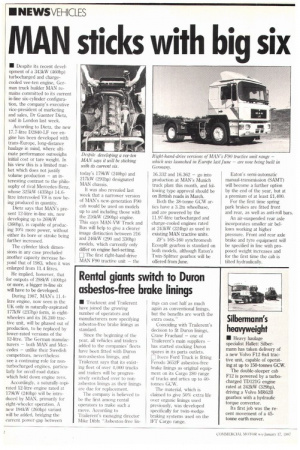MAN sticks with big six
Page 14

If you've noticed an error in this article please click here to report it so we can fix it.
• Despite its recent development of a 343kW (460hp) turbocharged and chargecooled vee-ten engine, German truck builder MAN remains committed to its current in-line six-cylinder configuration, the company's executive vice-president of marketing and sales, Dr Guenter Dietz, said in London last week.
According to Dietz, the new 17.7-litre D2840-LF vee engine has been developed with trans-Europe, long-distance haulage in mind, where ultimate performance outweighs initial cost or tare weight. In his view this is a limited market which does not justify volume production — an interesting contrast to the philosophy of rival Mercedes-Benz, whose 325kW (435hp) 14.6litre intercooled V8 is now being produced in quantity.
Dietz says that MAN's present 12-litre in-line six, now developing up to 269kW (360hp), is capable of producing 10% more power, without either its bore or stroke being further increased.
The cylinder block dimensions in any case precluded another capacity increase beyond that of 1983, when it was enlarged from 11.4 litres.
He implied, however, that for outputs of 298kW (40011p) or more, a bigger in-line six will have to be developed.
During 1987, MAN's 11.4litre engine, now seen in the UK only in naturally-aspirated 177kW (237hp) form, in eightwheelers and its 16.240 tractive unit, will be phased out of production, to be replaced by lower-rated versions of the 12-litre. The German manufacturers — both MAN and Mercedes — unlike their Swedish competitors, nevertheless see a continuing role for nonturbocharged engines, particularly for on/off-road duties which hold down engine revs.
Accordingly, a naturally-aspirated 12-litre engine rated at 179kW (240hp) will be introduced by MAN, primarily for eight-wheeler operation. A new 194kW (260hp) variant will be added, bridging the current power-gap between today's 179kW (240hp) and 217kW (291hp) designated MAN chassis.
It was also revealed last week that a narrower version of MAN's new-generation F90 cab would be used on models up to and including those with the 216kW (290hp) engine. This says MAN-VW Truck and Bus will help to give a clearer image distinction between 216 and 246kW (290 and 330hp) models, which currently only differ on engine fuel-setting.
The first right-hand-drive MAN F90 tractive unit — the 16.332 and 16.362 — go into production at MAN's Munich truck plant this month, and following type approval should be on British roads in March.
Both the 38-tonne GCW artics have a 3.2m wheelbase, and are powered by the 11.97-litre turbocharged and charge-cooled engines rated at 243kW (324hp) as used in existing MAN tractive units.
ZF's 16S-160 synchromesh Ecosplit gearbox is standard on both models, although Eaton's Twin-Splitter gearbox will be offered from June. Eaton's semi-automatic manual-transmission (SAMT) will become a further option by the end of the year, but at a premium of at least 21,400.
For the first time spring park brakes are fitted front and rear, as well as anti-roll bars.
An air-suspended rear axle incorporates smaller air bellows working at higher pressure. Front and rear axle brake and tyre equipment will be specified in line with proposed weight increases and for the first time the cab is tilted hydraulically.












































































